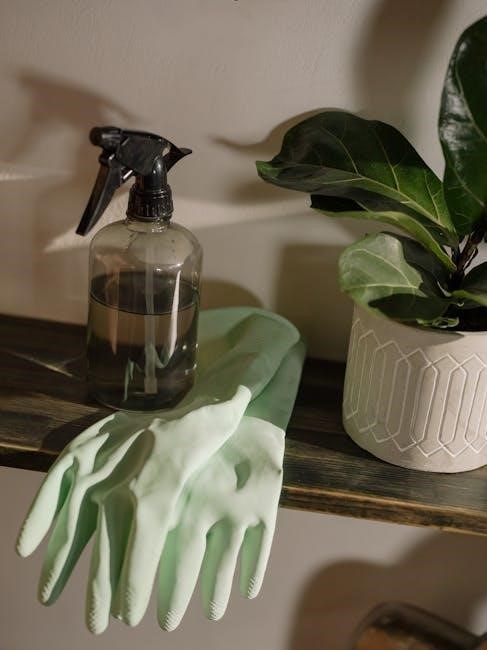OEKO-TEX Standard 100: Washing Instructions and Best Practices
The OEKO-TEX Standard 100 certification ensures textiles are free from harmful substances. Proper washing is vital to maintain the quality‚ safety‚ and longevity of these certified products. This section provides guidelines and instructions for washing OEKO-TEX textiles‚ ensuring they remain safe and sustainable.
What is OEKO-TEX Standard 100?
OEKO-TEX Standard 100 is a globally standardized‚ independent testing and certification system for textile products. Since 1992‚ this certification ensures that every component of an article‚ including threads‚ buttons‚ and accessories‚ has been tested for harmful substances. The STANDARD 100 label guarantees the product is harmless to human health.
This certification minimizes the environmental impact of the dyeing industry by ensuring processes capture and reuse water. It covers raw‚ semi-finished‚ and finished textile products at all production stages. Products are tested by independent institutes to verify they meet stringent criteria for harmful substances. Successfully tested products receive the STANDARD 100 label‚ indicating their safety and quality to consumers.
OEKO-TEX provides independent verification and reputation protection for businesses. It assures manufacturers‚ sourcers‚ and retailers that their products meet global safety standards. This certification enhances consumer confidence and supports sustainable textile practices by promoting the use of safer materials and production methods.

Understanding the OEKO-TEX Certification
The OEKO-TEX certification process involves rigorous testing of textile products to ensure they are free from harmful substances. This includes checking for chemicals that could be detrimental to human health. Every part of the product‚ from zippers to trims‚ must comply with strict OEKO-TEX criteria to receive certification.
Finished goods require their own certification‚ even if individual components are already certified. Converters who process materials (printing‚ finishing‚ washing‚ coating) but do not produce the material itself must also obtain certification. The certification system includes various standards like MADE IN GREEN‚ ORGANIC COTTON‚ and LEATHER STANDARD‚ each addressing specific aspects of textile production.

OEKO-TEX also offers STeP (Sustainable Textile Production) certification‚ promoting sustainable practices in textile facilities. The ECO PASSPORT certification verifies the safety of chemicals used in textile production. Understanding these certifications helps consumers make informed choices and supports manufacturers committed to responsible and eco-friendly practices‚ ensuring safer textiles for everyone.
The Importance of Following Washing Instructions
Following washing instructions for OEKO-TEX certified products is crucial to maintaining their quality and safety. These instructions are designed to protect the fabric’s integrity and prevent the release of any residual harmful substances during washing. Incorrect washing can damage the fibers‚ causing shrinkage‚ color fading‚ or weakening of the material.
Proper washing also ensures the longevity of the product. By adhering to the recommended water temperature‚ detergent type‚ and drying method‚ you can extend the life of your OEKO-TEX certified items. This is particularly important for eco-friendly fabrics‚ which may be more susceptible to damage from harsh chemicals and high temperatures.
Moreover‚ following washing instructions supports sustainability efforts. Using cold water‚ eco-friendly detergents‚ and avoiding excessive drying can reduce your environmental impact. By taking these steps‚ you not only care for your textiles but also contribute to a more sustainable lifestyle‚ aligning with the principles behind OEKO-TEX certification.
General Washing Guidelines for OEKO-TEX Certified Products
When washing OEKO-TEX certified products‚ several general guidelines should be followed to ensure the best results. Always check the care label for specific instructions‚ as these may vary depending on the fabric type and construction. Generally‚ it’s recommended to wash items in cold or warm water to prevent shrinkage and color fading; Hot water can damage fabric fibers over time.

Use a mild‚ eco-friendly detergent to avoid harsh chemicals that can harm both the fabric and the environment. Avoid using fabric softeners‚ as they can leave a residue on the fabric and reduce its breathability. For best results‚ turn items inside out before washing to protect the colors and prints.
When drying‚ tumble dry on low heat or‚ ideally‚ line dry to prevent damage from high temperatures. Avoid direct sunlight‚ which can cause colors to fade. Following these general guidelines will help maintain the quality and longevity of your OEKO-TEX certified products while also promoting sustainable practices.
Specific Washing Instructions Based on Fabric Type
Different fabric types require specific washing instructions to maintain their quality and appearance. For cotton and linen‚ machine washing in cold or warm water with a mild detergent is generally safe. However‚ avoid using bleach‚ as it can damage the fibers. Tumble dry on low or line dry to prevent shrinking.
Wool and delicate fabrics‚ on the other hand‚ require more care. Hand washing is often the best option to prevent stretching or damage. Use a detergent specifically designed for wool or delicates‚ and gently massage the fabric in lukewarm water. Rinse thoroughly and gently squeeze out excess water. Dry flat on a towel to maintain the garment’s shape.
For synthetic fabrics like polyester‚ machine washing in cold water is usually fine. Avoid using high heat in the dryer‚ as this can cause the fabric to melt or distort. Always refer to the care label for the most accurate and specific instructions tailored to your garment.
Cotton and Linen Washing Recommendations
Cotton and linen are natural fibers that are generally durable but require specific care to maintain their quality. When washing cotton and linen items certified under OEKO-TEX Standard 100‚ it’s best to use cold or warm water to prevent shrinking and color fading. Hot water can damage the fabric fibers over time.
A mild‚ eco-friendly detergent is recommended to avoid harsh chemicals that can degrade the fibers. Avoid using bleach‚ as it can weaken the fabric and cause discoloration. For colored items‚ turn them inside out to minimize fading during washing.
Drying methods also play a crucial role. Tumble drying on low heat or line drying is preferable to prevent shrinkage and maintain the fabric’s integrity. Sunlight can cause colors to fade‚ so drying in a shady spot is ideal. Proper care ensures these fabrics remain soft‚ durable‚ and safe‚ as guaranteed by the OEKO-TEX certification.
Washing Wool and Delicate Fabrics
Wool and delicate fabrics require special attention when washing to preserve their shape and softness‚ especially when they are OEKO-TEX Standard 100 certified. Hand washing is often the best method for these items. Fill a tub with lukewarm water‚ around 40 degrees Celsius‚ and add a gentle detergent specifically designed for wool and delicates.
Submerge the items and gently agitate the water‚ avoiding harsh scrubbing or twisting. Rinse thoroughly with clean‚ lukewarm water until all detergent is removed. To remove excess water‚ gently squeeze the fabric; avoid wringing‚ which can distort the shape.
Dry wool and delicate fabrics flat on a clean towel‚ away from direct sunlight‚ to prevent stretching and fading. Avoid using a machine dryer‚ as the heat can cause shrinkage and damage. Using the correct washing method ensures that these delicate OEKO-TEX certified items remain beautiful and safe for a long time.
Choosing the Right Detergent
Selecting the appropriate detergent is crucial for maintaining the quality and longevity of OEKO-TEX Standard 100 certified textiles. Harsh chemicals found in many conventional detergents can damage fabric fibers and potentially leave harmful residues‚ counteracting the benefits of the OEKO-TEX certification. Opt for mild‚ eco-friendly detergents that are free from dyes‚ synthetic fragrances‚ and sulfates. These detergents are gentler on fabrics and less likely to cause fading or irritation.
Consider detergents specifically formulated for delicate fabrics‚ as they often contain enzymes that help preserve the integrity of natural fibers like cotton and wool. Always check the detergent label for ingredients and certifications‚ ensuring it aligns with your commitment to sustainability and fabric care. Avoid using fabric softeners‚ as they can leave a coating on the fabric that reduces its breathability and softness. By choosing the right detergent‚ you can effectively clean your OEKO-TEX certified items while minimizing environmental impact and extending their lifespan.
Eco-Friendly Detergent Options
With increasing awareness of environmental impact‚ numerous eco-friendly detergent options are available for washing OEKO-TEX Standard 100 certified textiles. Look for plant-based detergents that utilize biodegradable ingredients‚ minimizing harm to aquatic ecosystems. Brands offering refill programs are an excellent choice‚ reducing plastic waste and promoting a closed-loop system. These detergents often exclude harsh chemicals‚ dyes‚ and synthetic fragrances‚ making them suitable for sensitive skin and delicate fabrics.
Consider Australian-made detergents with transparent ingredient lists‚ ensuring you know exactly what you’re using. Some eco-friendly detergents are specifically formulated for wool and delicate items‚ preserving their natural properties. Additionally‚ explore detergents with stain-removing capabilities that are gentle on fabric fibers. Opting for eco-friendly detergents aligns with the sustainable ethos of OEKO-TEX certification‚ promoting both textile safety and environmental responsibility. By making informed choices‚ you can effectively clean your textiles while minimizing your ecological footprint and supporting sustainable businesses.
Drying OEKO-TEX Certified Textiles
Proper drying techniques are essential for maintaining the quality and longevity of OEKO-TEX certified textiles. Whenever possible‚ air drying is preferable to machine drying. Air drying reduces energy consumption and minimizes wear and tear on the fabric. For delicate items and woolens‚ drying flat on a clean towel is recommended to prevent stretching and maintain their shape. Avoid direct sunlight when drying colored fabrics‚ as prolonged exposure can cause fading.
If using a machine dryer‚ opt for a low heat setting to prevent shrinkage and damage to the fibers. Remove items promptly once dry to avoid wrinkles. Consider using dryer balls to reduce drying time and soften fabrics naturally. Pay attention to the care label instructions for specific drying recommendations. Proper drying practices not only extend the lifespan of your OEKO-TEX certified textiles but also contribute to sustainable laundry habits. Always ensure that your drying methods complement the careful washing routines you’ve established.
Sunlight and Color Fading
Sunlight‚ while beneficial for disinfecting and naturally brightening fabrics‚ can also contribute to color fading in OEKO-TEX certified textiles. The UV rays in sunlight break down the dyes‚ especially in vibrant and darker colors. To minimize fading‚ it’s best to dry colored items in a shady spot or dappled sunlight. Turning clothes inside out before drying can also help protect the outer layer from direct sun exposure‚ preserving the color intensity.
For items that are particularly susceptible to fading‚ consider drying them indoors on a drying rack. If you must dry items outdoors‚ limit the amount of time they are exposed to direct sunlight. Using a clothesline in a shaded area or a covered porch can effectively reduce the risk of color fading. Remember that OEKO-TEX certified dyes are designed to be gentler on the environment‚ so some fading over time is normal. By taking these simple precautions‚ you can prolong the vibrancy of your textiles and keep them looking their best.
Extending the Life of OEKO-TEX Certified Items
To extend the life of OEKO-TEX certified items‚ it’s crucial to adopt mindful washing and care practices. Begin by always checking the care label for specific instructions‚ as different fabrics may require different treatments. Washing items inside out can reduce friction and wear on the outer surface‚ preserving color and preventing pilling. Avoid overloading the washing machine to ensure thorough cleaning and prevent damage from excessive rubbing.
Opt for gentle wash cycles and mild‚ eco-friendly detergents to protect fabric fibers and dyes. Consider using a mesh laundry bag for delicate items to prevent snagging and stretching. When drying‚ avoid high heat‚ which can cause shrinkage and damage. Instead‚ choose low heat or air-drying options. Store your OEKO-TEX certified items in a cool‚ dry place away from direct sunlight to prevent fading and degradation. By following these practices‚ you can significantly prolong the life and maintain the quality of your textiles.

OEKO-TEX and Sustainable Practices
OEKO-TEX certification plays a significant role in promoting sustainable practices within the textile industry. By ensuring that textiles are free from harmful substances‚ OEKO-TEX supports healthier environments and reduces the negative impact of textile production on ecosystems and human health. The certification encourages manufacturers to adopt cleaner production methods‚ minimizing water and energy consumption‚ and reducing waste;
OEKO-TEX also promotes responsible chemical management‚ ensuring that dyes and other chemicals used in textile processing meet stringent environmental standards. Consumers who choose OEKO-TEX certified products contribute to a more sustainable supply chain‚ supporting companies committed to ethical and environmentally friendly practices. Furthermore‚ the OEKO-TEX system includes initiatives like STeP (Sustainable Textile Production)‚ which focuses on sustainable manufacturing processes‚ and Made in Green‚ which ensures both ecological and social responsibility. By integrating these practices‚ OEKO-TEX helps to create a more sustainable and transparent textile industry‚ benefiting both the environment and consumers.
